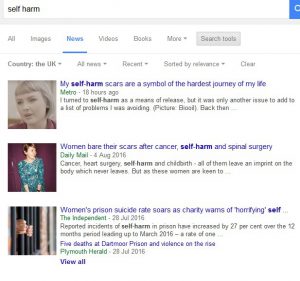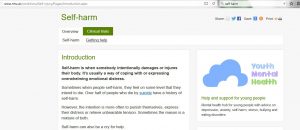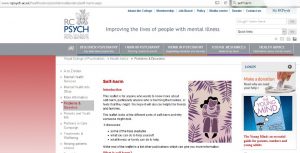Self Harm: Age & Gender – Perception and Reality
This post looks at how well some of the perceived characteristics of people who self-harm, Age and Gender, fit with the reality of Self Harm in the community.
For most non experts, and undoubtedly a few experts as well, the perception of people who self=harm is one of almost exclusively young, teenage, and predominately female. This is not surprising as the language, images and targeting of both press reports, Support and information organisations web sites as well as academic papers reinforce that perception.
While it is obviously difficult to fully and accurately understand the demographic makeup of the people who shelf-harm, it is often a secret activity, we can, I suggest, get a first level approximation of the issue from those presenting to hospital emergency departments.
Statistics from the south west of England do not support the stereotype that it is teens and young people – 15-29 that are the majority group.
In fact the 30-44 age range present at hospital in almost identical numbers with the 45 – 74 age group reaching 50% of the numbers of the younger groups.
The same statistics also show only a excess of females presenting in the 15-29 age group but with the gap narrowing in the older age groups
I think form this it if fair to say that self-harm impacts both genders and all ages, and while young females do seem to have a higher prevalence of self-harm the statistics do show that the perception of self-harm as a predominantly young female issues is far from the truth.
Self-Harm: Age and Gender
Watching new reports or reading the press would lead many people to believe that self harm was predominantly, if not exclusively an issue for young women. A quick Google search of news items for example, shows how this is presented, The top 3 items on such a search, performed 15-8-2016 were related to women
And it not just the press that are to blame. Government web sites as well as those for mental health charities also perpetuate the stereotypes, in the images they use.
The NHS web site for example links self-harm with ‘Young’ mental health.
 with Mind using an image of a young woman to illustrate its web site on self-harm.
with Mind using an image of a young woman to illustrate its web site on self-harm.
Even the ‘Royal Collage of Psychiatrists’ use a female gendered image and link to ‘young’ mind
However the statistics do not seem to totally reflect this almost universal perception of people who self-harm being young and female.
If we look at the statistics produced by the South West Public Health Observatory we can see for the years 2001/2 to 2008/9 we see that Males and adult age groups make up a significant fraction of the total admission to hospital
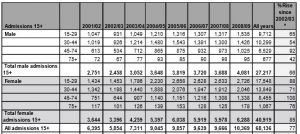 From this we can see, in 2008/9 for example that almost 40% of admissions were male and almost 60% of admissions for self harm were aged over 30
From this we can see, in 2008/9 for example that almost 40% of admissions were male and almost 60% of admissions for self harm were aged over 30
A similar pattern can be seen for earlier years with males making up 38% of admissions in 2007/8 and 2006/7
Over 30s made up 60% of admissions in 2007/8 and 59% in 2006/7
Aggregated statistics for the south west have not been published for the period 2009/10 onwards but a series of freedom of information requests to individual Clinical Commissioning groups (CCG) show very much the same pattern
For Somerset CCG for example
 Again we can see that adult self-harm forms a significant proportion of admissions.
Again we can see that adult self-harm forms a significant proportion of admissions.
In 2015/16 17% of admissions for self-harm were aged over 45 with 38% of them being males.
North, East & West Devon CCG for example shows a similar result
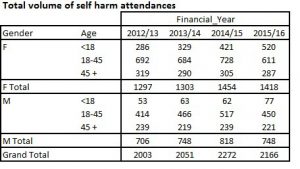 With 23% of attendees being over 45 in 2015/16 and 35% being male.
With 23% of attendees being over 45 in 2015/16 and 35% being male.
Obviously those attending hospital may not for a total representative sample so I identified different data set, those self-harming while in Prison.
Annual self-harm incidents by age group and calendar year, England and Wales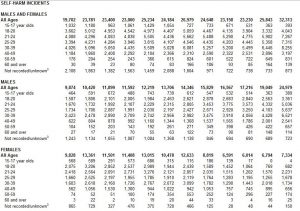
2004-2015
We can see from these figures that in 2015 77% Males in 2015 and that 13% of them were over 40. Obviously these figures are skewed but the relative numbers of males and female in custody, with males far outnumbering the females.
Looking at the relative prison populations:
We see that females make up 4.5%, a figure that has remained relatively static over the last few years
Applying this correction gives us a result that just over 13% of self-harm in the prison population was committed by males. This figure is significantly lower than that seen in hospital admission but still a significant number.
This may be explained by the differing nature of the prison population and regimes in place, but this would need further research to determine.
Conclusion
I think it fair to say that while the predominant population of Self-harmers are female and younger, late teens to late twenties the numbers of both male self-harmers and people in older age groups that self-harm are significant.
It would be nice to think that the media would reflect this divers population but that is, in all probability a forlorn hope. However it would be expected that the charities involved with people who self harm, as well as the NHS and other statutory services should recognise the range of genders and ages of the people who self harm in both their publicity, web sites and service provision.

